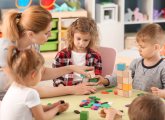Laura England creates a new space to learn, discovers nature’s art supplies and shares engaging ways to match and sort…
In our setting we have free-flow access to the outdoor area, which means that many of the children choose to spend nearly their entire day in the fresh air. We decided to create an outdoor classroom to further extend the outdoor space and to create a dedicated area for outdoor development. We wanted the structure to be in keeping with its surrounding, so we opted for a wooden shed with floor-to-ceiling windows.
Within the classroom we have lots of resources that cannot be left outdoors but are great for investigating the space – for example, paper, pencils, maps, reference books, walkie talkies, scales, magnifying glasses and much more. And we now have a cosy space where children can have a nap or enjoy a rest from the elements, particularly in the colder months!
When it comes to art, you don’t need lots of expensive or fancy materials; nature provides a wealth of opportunities for children to discover and create. Why not try making pictures with all the natural loose parts available to you, such as leaves, petals, stones, sticks and pine cones? These materials will allow children to create and recreate all year round. You can even turn natural loose parts into paint brushes by attaching leaves or petals to the ends of sticks, and use water and mud instead of paint!
Use nature as your muse: can the children mix paints to match the colours of leaves? Can they draw a picture of the sun? What effects do different surfaces create? Our current muse is light and shadow, and the children have been chalking around and painting shadows.
Continuing with the theme of nature and budget-friendly ideas, why not use the outdoors for counting, sorting and ordering? We collected paint card samples from our local hardware store and used elastic bands to attach them to a length of thick card (you could use cardboard tubes, clipboards or place the samples in a tinker tray instead). The children then took these on their travels; they collected items that matched the paint card samples and developed their fine motor skills as they positioned them under the elastic bands. This is great for problem solving as there are lots of different shades of the same colour.
To extend this we’re going to sort our natural items by size and shape; it’s great to size-order natural loose parts because it involves lots of critical thinking and there’s usually a number of solutions due to the differing lengths and widths of natural items.
Not a Stick
By Antoinette Portis
I often get asked about books that promote loose-parts play – well, try having a look at Not a Stick by Antoinette Portis. The follow up to Not a Box, it celebrates the power of imagination and creativity when using everyday objects.
Laura England is preschool leader at Blythe Bridge Day Nursery and the author of Schemas: A Practical Handbook. Follow @littlemiss_ey

How Does Early Years Practice Differ in Europe?
Editors picks
